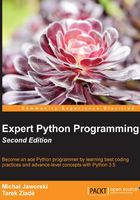
Chapter 3. Syntax Best Practices – above the Class Level
We will now focus on syntax best practices for classes. It is not intended to cover design patterns here, as they will be discussed in Chapter 14, Useful Design Patterns. This chapter gives an overview of the advanced Python syntax to manipulate and enhance the class code.
Object model evolved greatly during history of Python 2. For a long time we lived in a world where two implementations of the object-oriented programming paradigm coexisted in the same language. These two models were simply referred to as old-style and new-style classes. Python 3 ended this dichotomy and only model known as new-style classes is available to the developers. Anyway, it is still important to know how both of them worked in Python 2 because it will help you in porting old code and writing backwards compatible applications. Knowing how the object model changed will also help you in understanding why it is designed that way right now. This is the reason why the following chapter will have a relatively large number of notes about old Python 2 features despite this book targets the latest Python 3 releases.
The following topics will be discussed in this chapter:
- Subclassing built-in types
- Accessing methods from super classes
- Using properties and slots
- Metaprogramming